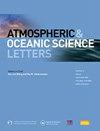Impacts of observation-based cloud droplet size distributions on the simulation of warm stratiform precipitation using a double-moment microphysics scheme
IF 3.2
4区 地球科学
Q3 METEOROLOGY & ATMOSPHERIC SCIENCES
引用次数: 0
Abstract
A double-moment cloud microphysics scheme requires an assumption for cloud droplet size distributions (DSDs). However, since observations of cloud DSDs are limited, default values for shape parameters and cloud condensation nuclei activation parameters are often used in numerical simulations. In this study, the effects of cloud DSDs on numerical simulations of warm stratiform precipitation around Tokyo are investigated using the Japan Meteorological Agency's non-hydrostatic model, which incorporates a double-moment cloud microphysics scheme. Simulations using the default cloud DSD showed higher cloud droplet number concentrations and lower radar reflectivity than observed data, suggesting that the default cloud DSD is too narrow. Simulations with a cloud DSD based on in situ cloud observations corrected these errors. In addition, observation-based cloud DSDs affected rainfall amounts through the autoconversion rate of cloud water and improved the threat scores. These results suggest that realistic cloud DSDs should be provided for double-moment cloud microphysics schemes in scientific studies.

基于观测的云滴大小分布对双矩微物理方案模拟暖层降水的影响
双矩云微物理方案需要对云滴尺寸分布(dds)进行假设。然而,由于云的DSDs观测有限,在数值模拟中经常使用形状参数和云凝结核激活参数的默认值。本文采用日本气象厅的非流体静力模式,采用双矩云微物理方案,研究了云DSDs对东京附近暖层降水数值模拟的影响。使用默认云DSD的模拟结果显示,与观测数据相比,云滴数浓度较高,雷达反射率较低,表明默认云DSD过窄。基于现场云观测的云DSD模拟修正了这些误差。此外,基于观测的云DSDs通过云水的自转换率影响降雨量,提高了威胁评分。这些结果表明,在科学研究中应该为双矩云微物理方案提供真实的云dsd。
本文章由计算机程序翻译,如有差异,请以英文原文为准。
求助全文
约1分钟内获得全文
求助全文
来源期刊

Atmospheric and Oceanic Science Letters
METEOROLOGY & ATMOSPHERIC SCIENCES-
CiteScore
4.20
自引率
8.70%
发文量
925
审稿时长
12 weeks
 求助内容:
求助内容: 应助结果提醒方式:
应助结果提醒方式:


